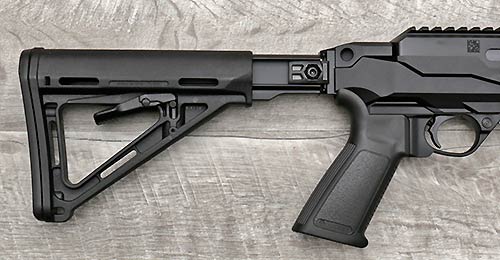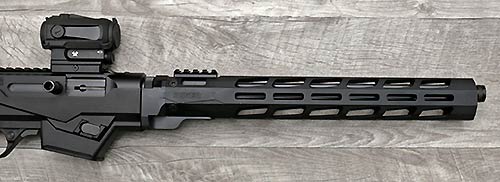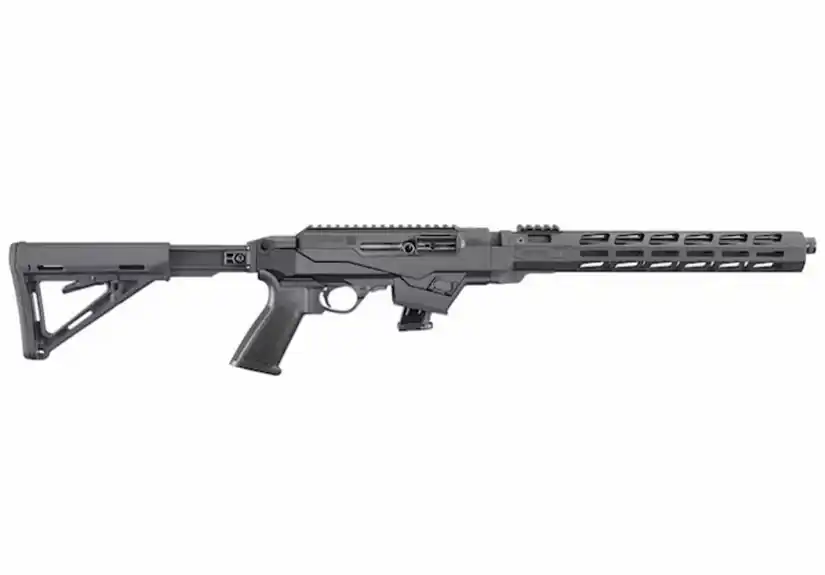Back in 2018, when I bought my first Ruger PC Carbine, there was pretty much one option. That was the sporter-style synthetic stock, and it’s not bad at all. But Ruger came out with some newer models, one of which includes an adjustable stock, pistol grip, and free-float handguard. Since this is closer to the configuration I really wanted, I reached out to Ruger for a loaner. I’m already very familiar with the platform, so rather than a review, I wanted to see how it compared to the original.

Ruger PC Carbine: The same, just different
If you’ve read my PC Charger review, then you know the history of the design. Or you might have already known that the PC Carbine is based on the Ruger PC9, which was based on the Ruger 10/22 design. The 10/22 has been around since 1964, and in 2015, sales exceeded 7 million units. It’s a successful design, and scaling it up from rimfire to 9mm has worked well for the PC Carbine. As Ruger is known to do when they have a successful product, they created some variations. So the pictured model is the same as my original one, just different in some ways.

The receiver itself, and all internal components, haven’t changed. But the rear half of the stock has been replaced with a more modular chassis. AR-pattern pistol grips can now be fitted. A Picatinny rail on the rear of the receiver holds an extension that accepts AR-style stocks. And the forend, which rested under the barrel, has been replaced with a free-floated aluminum M-LOK-compatible handguard. It still ships with a Ruger handgun magazine, and an extra magwell that’s Glock-compatible. If you’re already invested in the Ruger American, or plan to be, Ruger will sell you a compatible magazine well for those mags too.
A little more of the same
The chassis, which houses the same 7075-T6 aluminum Type III hardcoat receiver, is still glass-filled polymer. While the original PC Carbine shipped with a Ruger SR9 magazine, the new model ships with a Security 9 magazine. It seems either will work in the PC Carbine, but the older SR9 mag doesn’t play well with a Security 9 pistol. Beyond that, all controls are in the same place, and function the same as well.
A little bit different. Okay, maybe a lot
Although Ruger doesn’t call this rifle “optics ready”, it is. That’s marketing-speak for not having any sights. One concession to the nice handguard was the exclusion of iron sights. So you’ve got the railed receiver, and a small section of rail near the back of the handguard, for mounting an optic. As long as we’re discussing concessions, it should be pointed out that the barrel is not centered vertically in the handguard. At first glance, it might look like that was so the little rail section would line up with the receiver. But it seems more likely that it was to accommodate the takedown mechanism beneath the barrel.

It’s possible that it could have been designed with the barrel centered, and the mechanism left below, or outside the handguard. Raising the handguard to center the barrel wouldn’t interfere with anything, but it might look unusual. MSR free-float handguards are designed to be seamless with the receiver, and I think that’s where Ruger took their design cues. Either way, I think it looks great. Aftermarket handguards for this model and the original follow the same lines, so it’s clearly been accepted.
Other Features
At the rear of the receiver are a pair of QD sling sockets. If a single point sling isn’t your style, you can still attach one to the stock or replace the stock with one that has more attachment points. And then add another attachment point directly to the M-LOK handguard. Also, if forward grips, lights, and lasers are your thing, there is plenty of room along the handguard‘s M-LOK slots at 3, 6, 9, and 12 o‘clock. Poking out from the end of the handguard is less than an inch of the 16.12″ barrel. Just enough for a thread protector hiding some 1/2 x 28 threads. Plenty of owners have added a compensator or suppressor of their choice.

Like the other models, the charging handle can easily be swapped to either side. For the serious operator, run one on each side. Same with the magazine release – it’s user swappable from side to side. And if you don’t like them, the aftermarket has you covered. Ruger makes it easy to customize the platform, and even offers third-party parts on their website. It’s as though they’re saying “Go ahead and replace these parts with aftermarket. Just buy them from us.” Or something like that. If you can’t customize the PC Carbine to suit you, it’s not Ruger’s fault.
Disassembly and assembly
Takedown of this newer model is the same as the original, although the mechanism appears to be a bit nicer. Lock the bolt back, pull the takedown lever with your thumb, and give it a twist. Assembly is the reverse. As always, the important thing is to make sure the bolt is back before twisting. On a 10/22, this is to prevent damage to the extractor. With the PC Carbine, it simply won’t come apart or go together unless the bolt is back, as the barrel locks into the bolt.
While some might question the need for the little PC Charger to be a takedown, it does make more sense with the PC Carbine. Besides cleaning, it’s much handier to store and transport in a small bag or backpack, rather than a long rifle case. Across all models, it’s also important to remember that the barrel lockring needs to be properly adjusted. Too tight, and it won’t come apart. Too loose, and it’s rattly, and probably dangerous, or at least inaccurate. The manual covers proper adjustment, and following Ruger’s recommendation is advised.
Prepping for some lead-slinging
Since I have some Security 9 magazines, and this is a loaner rifle, I left the Ruger magwell installed. As fun as mag dumps with a Glock drum might be, it’s not going to happen at current ammo prices. But replacing the magwell is quite easy. I also kept the charging handle on the right, and magazine release on the left.
The only change made was to add an optic. After trying several on the PC Charger, I settled on the Vortex SPARC II. So I bought another to use on the PC Carbine. Solid construction, long eye relief, and wallet-friendly. The last item was to secure some ammo. One of my local shops was kind enough to sell me a box of 200 at a very reasonable price, which was enough for this quick shakedown.
Find the Ruger PC Carbine at Brownells
Range time
At the range, this carbine handled much like my original one. Though I have to admit, I prefer the pistol grip, and adjustable stock. TandemKross does make their Upriser chassis, which lets you use both with the original model. But this is more aesthetically pleasing, although the stock is a bit loose and noisy. That’s mostly expected from Magpul, and one of the first things I would consider replacing. Bringing it up to my shoulder, I don’t really notice the extra mass (7.3 pounds to the original’s 6.8). Recoil is mild, thanks to the tungsten dead blow weight. And the fact that I shot my Ruger .308 before I shot the PC Carbine. Everything seems mild after that.
As expected, there were zero malfunctions over 200 rounds of high quality (not really, just high priced) Winchester range ammo. Since this review is more about the gun features and handling, I didn’t think I would need to do a high round torture test on a proven platform. Also, ammo prices. Hopefully you’re just nodding your head in agreement to that last part.
Limited to 25 yards indoors (it was about 20 degrees outside), it was easy enough shoot smiley faces into the target. Five shot groups just leave a single ragged hole. When it warms up, I’ll take it out for some steel at 50 to 100 yards, but I am confident it will shoot at least as well as my own rifle does.

Find the Ruger PC Carbine and accessories at MidwayUSA
Conclusion
It may be obvious by now that I certainly prefer the newer model, compared to my original. I like shooting, and customizing. And I like a rifle that combines the 9mm round with the modularity of the AR platform. If this was my rifle, I would probably swap the grip for a sticky Hogue. And then replace the stock with something less noisy. Pretty sure I have a Hogue AR stock, which would be ideal. Then I’d set up the charging handle and magazine release to match my PC Charger.
As delivered, this PC Carbine carries an MSRP of $150 over the price of the original. In my opinion, it’s worth the extra money. Just being able to adjust the length of pull from 10.50″ to 13.75″ for my wife and daughter is a huge plus. Had I known this was going to be released, would I have delayed my purchase? Probably. If you set them both on the counter in front of me today, I’d pick this one without looking at the price tag of either. Ruger really did well with their first release. And then they nailed it with this one.
I‘d like to thank Ruger for loaning me their Ruger PC Charger for this review. Check it out at Ruger.com.
Quick details
Model 19122. Accepts all Ruger Security 9 magazines by default, and ships with one 17 round magazine. Glock double-stack 9mm magwell insert included. Weight 7.3 pounds. Overall length is 32.25″ – 35.50″, with a 16.12’³ barrel. MSRP $799.00
Comments? Questions? Do any of our readers own the PC Carbine and/or Charger? Is the sequel better than the original? Feel free to share below.
